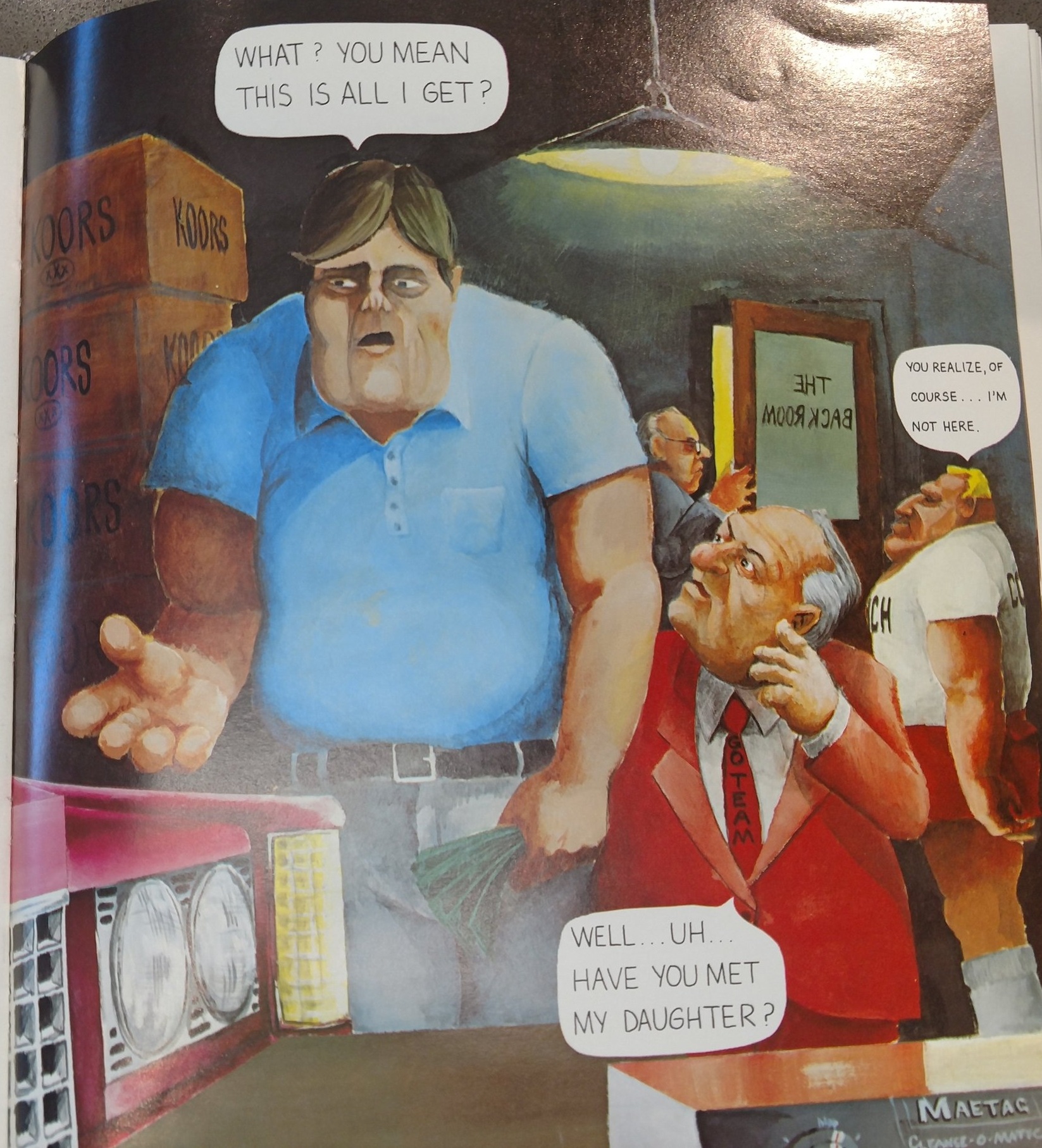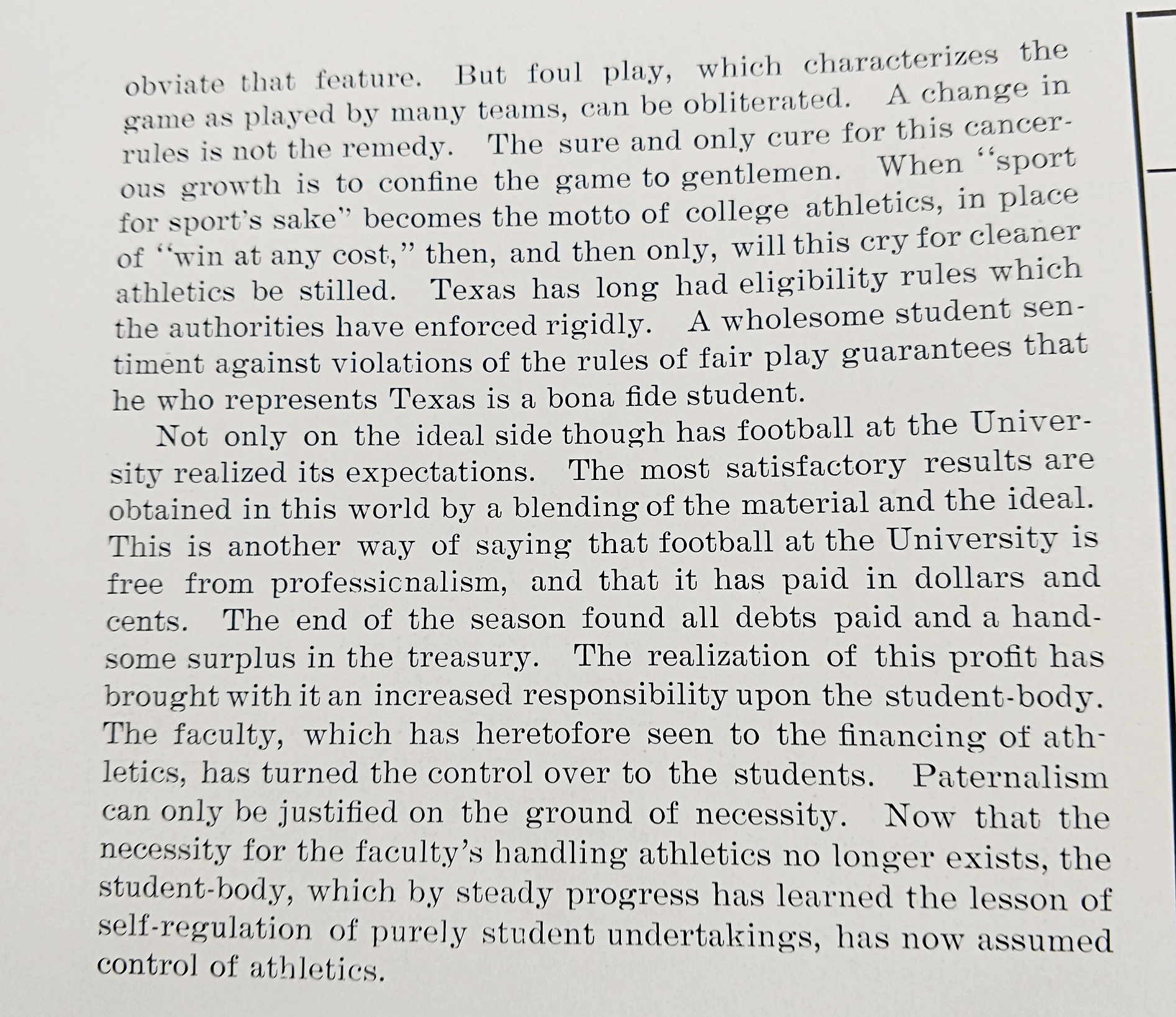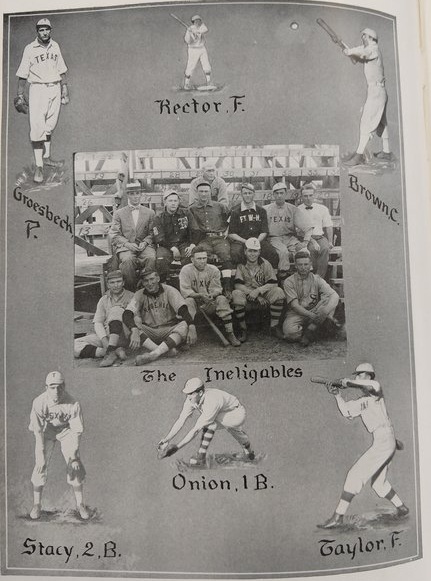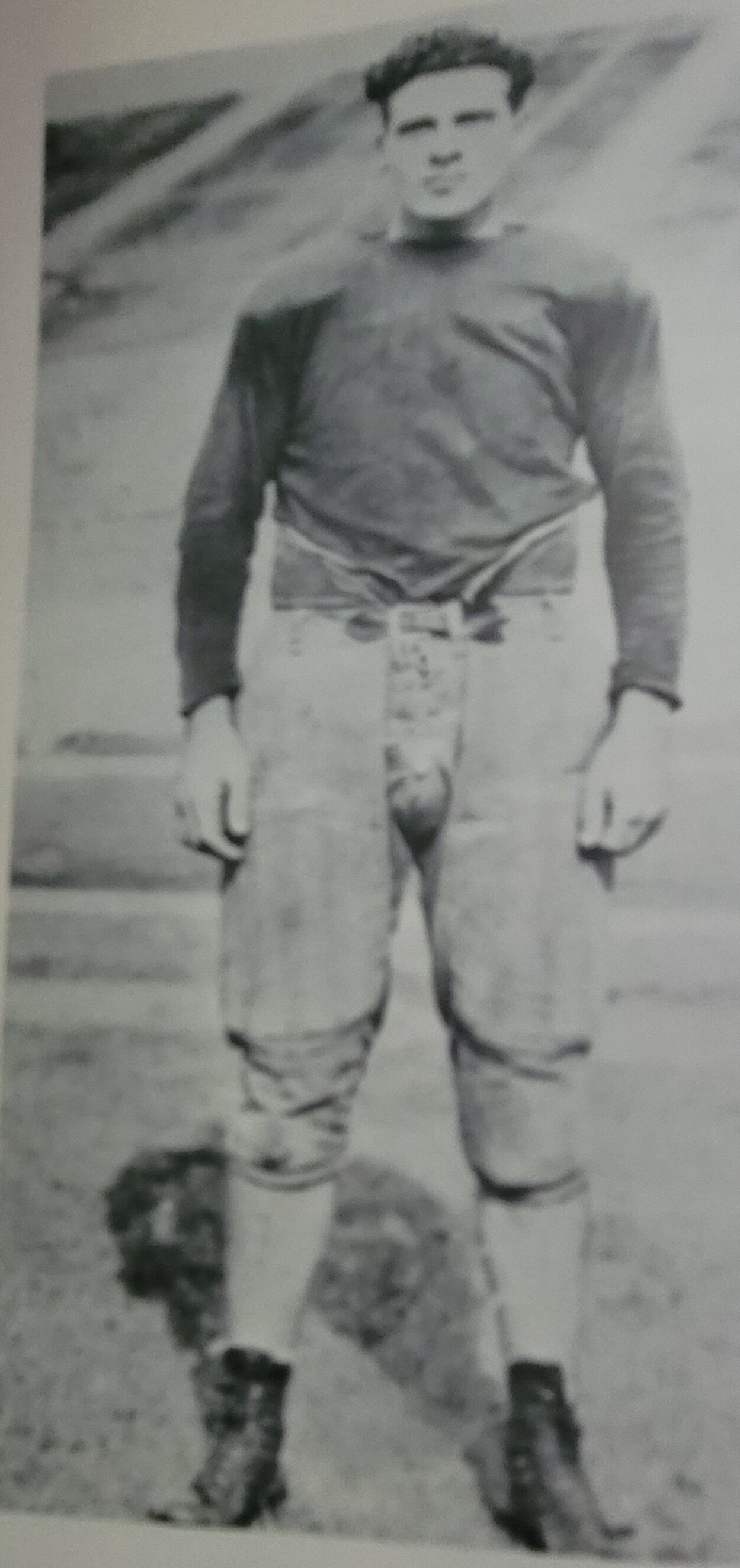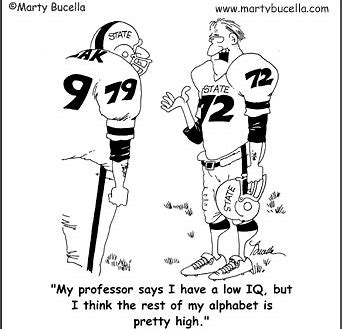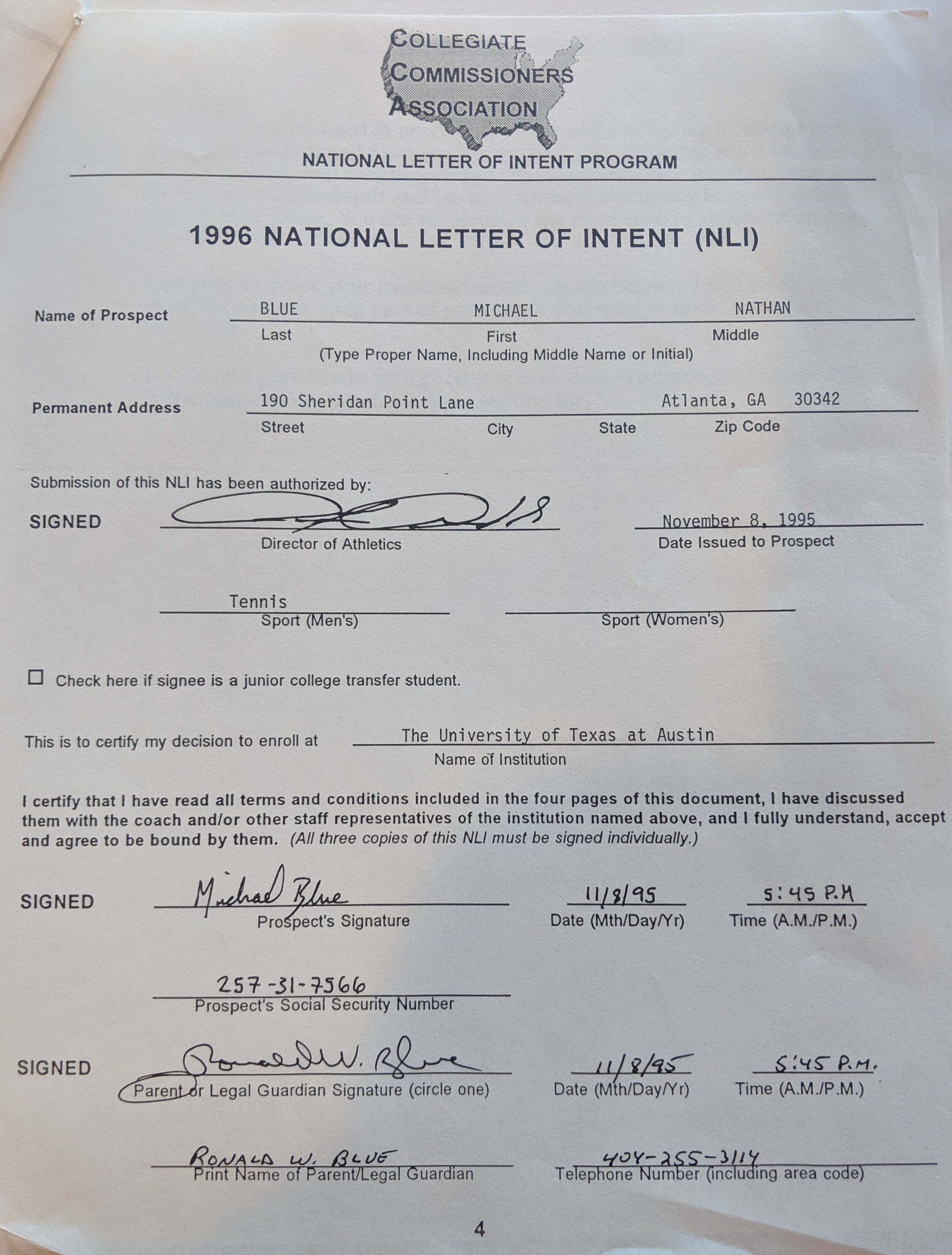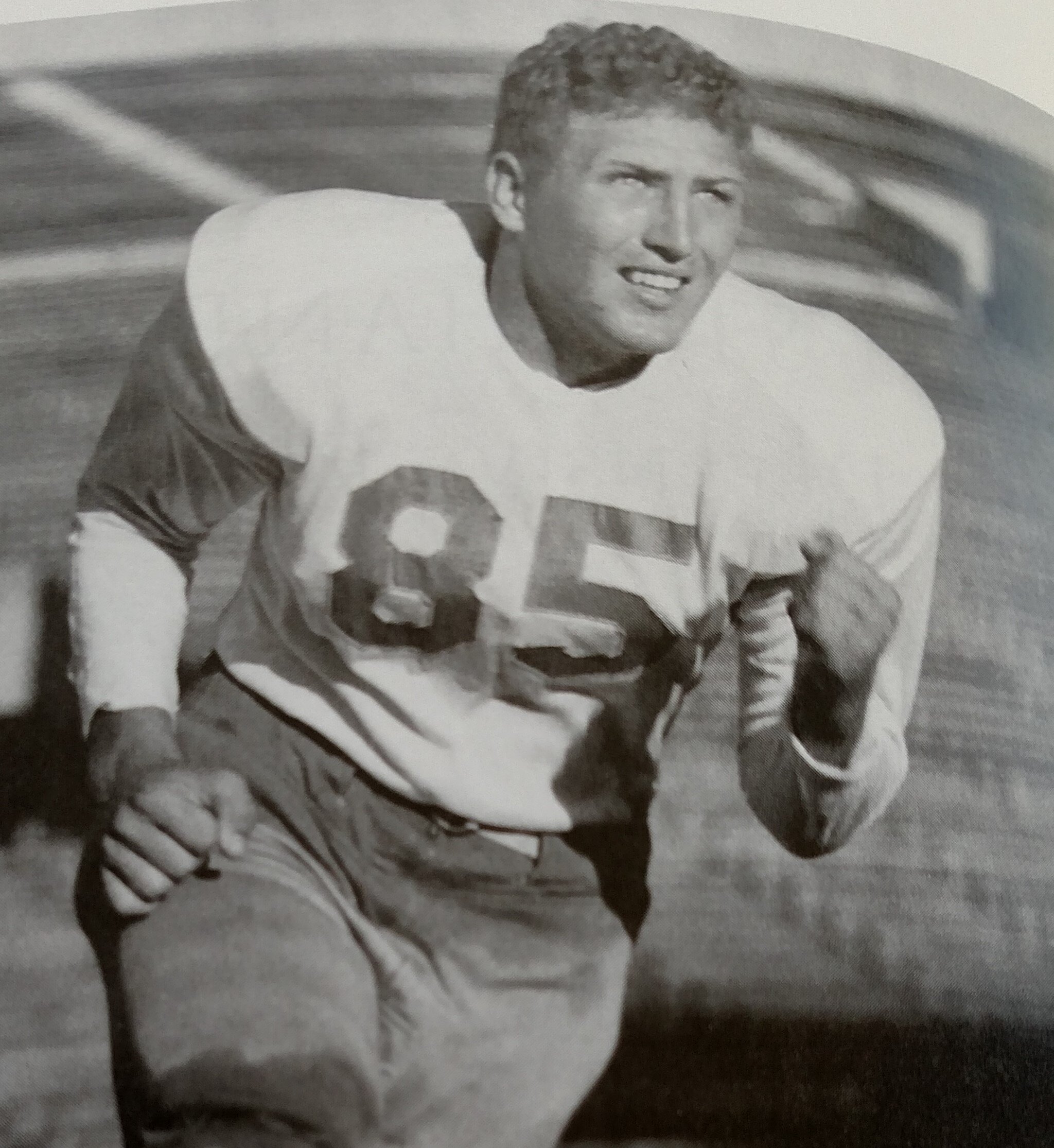TABLE OF CONTENTS to the History of recruiting infractions - 1900-1959
The NIl,
NCAA Infractions: The Record No University Wants To Hold,
CHRONOLOGY OF NCAA's rules, infractions, and the recruiting process 1890’s thru 1930,
CHRONOLOGY OF NCAA's rules, infractions, and the recruiting process 1930 thru 1944,
CHRONOLOGY OF NCAA's rules, infractions, and the recruiting process 1945 thru the 1950s, and
#5 During the 1950s and 1960s, the NCAA's enforcement capacity increased annually.
#1
Is the transition from money as an illegal recruiting tool to a legal process in the NIL system a friend or foe to the future of college sports?
Scholarship athletes in college should receive compensation, and the NIL system has been blessed by all the major collegiate institutional leaders as the legal form to pay athletes. BUT.....
Money has always been a corrupting influence in college sports. NCAA compliance history tells of money's corrupting influence on college sports 100s if not 1000s of times. Unfortunately, with the NIL, it is now legal for those with money to buy a winner. It is happening now!
So I struggled to find a word that captured my feelings about the NIL's future in college sports, and I finally found the word. Faustian means "made or done for present gain without regard for future cost or consequences." A Faustian moment is at hand in the future of college sports. Corruption will follow with no ceiling on money to pay young boys turning to men.
Talk show host and former record-setting Longhorn JEFF Ward also thinks this is a Faustian moment for college football.
“The problem the college game is experiencing isn’t because players are getting paid, sort of. The problem is the industry is and was completely ill-prepared for any of the changes. The college game’s lack of leadership is creating an unmanageable environment that I think will only get more chaotic. There are no guardrails. Dabo Swinney and Nick Saban have raised the issue recently. They’re right. League commissioners can’t get control. University Presidents are afraid to get control of their own programs, and coaches are afraid to say no to any recruit. What you have is a directionless environment with no rules because there is no leadership structure, and coaches don’t want to implement any rules out of fear the next blue- chip prospect will go elsewhere. A lot of money is floating around and while you may argue the players ``deserve” it, there is no guidance in place.
It’s like the ‘80s all over again, but slightly more above board. ”
It is ok to cheat but don’t get caught was the collegiate recruiting rule up to 2020.
Up until 2020 the collegiate recruiting rule was It is ok to cheat, but don’t get caught. In 1980 the book "Down and Dirty- The Life and & Crimes of Oklahoma football," the comment is made that athletes at the college level learned that If they gave their best on the Football field, they were allowed to do their worst off it, and the coaches and boosters would clean up the mess." As fans, boosters, coaches, and college administrators in 2022, have we reverted to the 1980s genre of cleaning up messes that the NIL compensation system will create. Will we have to clean up the mess where 18 and 19 years boys choose money first with education is just a sidebar- an adjunct to playing college sports?
Links to the history of NCAA infractions from 1900 to 2020 are listed below.
Image from the Cactus
#2 NCAA Infractions: The Record No University Wants To Hold
"Every time they change the rules, somebody comes up with something," said Conference USA commissioner Britton Banowsky, who in previous jobs attempted to help manage the madness as the chief compliance officer for the Southland, Southwest, and Big 12 conferences. "Invariably, that means they get right up to the edge of the line sometimes. ... The unfortunate thing is the line is not always clearly defined."
Here are the teams with the most infractions, according to the NCAA.
SMU, 10
Arizona State, 9
Oklahoma, 8 Four of these were in 1955, 1960, 1973, and 1988
In 1958 -cheating was running rampant, and the media and fans celebrated the cheaters. Don Faurot tells the Saturday Evening Post, “ The nation’s press could help by ceasing to glorify the successful lawbreakers. According to When Football Becomes War by Robert Heard O.U. is the worst violator. Don Faurot and Robert Heard have legitimate points. As of 2019, 7 of the 13 universities that broke NCAA rules have winning programs.
In the late 1960s and throughout the '70s, no group of coaches walked this fine line better than the football staff at Oklahoma. Though former Texas coach Darrell Royal and others accused Oklahoma's Barry Switzer of a number of dirty tricks on the recruiting trail, in many cases, Switzer and company simply used existing rules to their advantage.
One example of the Oklahoma coach's genius involved a 1968 Southwest Conference rule that allowed conference staffs to visit a recruit only once. Oklahoma, a member of the Big 8, was bound by no such rule. So Switzer, then a Sooners assistant, essentially lived three days a week at the home of Abilene, Texas, quarterback Jack Mildren. According to his 1990 autobiography, Bootlegger's Boy, Switzer spent many an evening at Mildren's house watching Dolly Parton and Porter Waggoner on television alongside Mildren's parents. One night, as Switzer helped Mildred's mother, Mary Glen, with the dishes, Texas A&M coach Gene Stallings and his staff arrived for their one visit with Mildren. As Switzer walked past the Aggies coaches, he turned and called back to Mildren's mother. "Why don't you just leave these dishes and go visit with them?" Switzer said. "I'll come back and help you finish them later."
Two hours later, Stallings and his assistants walked out to find Switzer waiting. Switzer finished the dishes, and he signed Mildren, who became the first great Wishbone quarterback at Oklahoma. The SWC quickly repealed the rule.
The Oklahoma staff used the SWC rulebook as a shield whenever possible. Larry Lacewell, a longtime Switzer assistant who also served as head coach at Arkansas State and as the Dallas Cowboys' director of player personnel, said the Sooners loved the fact that the SWC had its own Letter of Intent. When a player signed with an SWC school, he was off-limits to coaches from the other SWC schools, but not to coaches from schools in other conferences.
"We'd get them to sign with Baylor or TCU," Lacewell recalled with a laugh. That way, Texas and Texas A&M couldn't recruit them, but Oklahoma could.
https://youtu.be/Ck6hujEjIPc
Wichita State, 8
Auburn, 7
Florida State, 7
Texas A&M, 7
University of California (Berkeley), 7
Georgia, 7
Memphis, 7
Minnesota, 7
Wisconsin, 7
West Virginia, 7
In 1971 while coaching basketball at OCU, "Lemons turned in OU for some NCAA violations. Abe Lemons was shocked when fans and newspapers were upset that he reported OU. Abe said one coach accuses another coach of cheating, and "everyone wants to know who the dirty rat was the turned him in (the cheater)." Abe says, "You can't legislate integrity. When the rules are bent or broken, there's a tendency for coaches to wink at each other. The whole thing has gotten out of hand. There's no way for the NCAA to enforce the rules except to start giving lie detector tests."
He says, "You try to be straight, run a clean program, and somebody down the road is cheating, trying to put you out of business, but if you yell, you're the one who is scorned. "
In 1975 University of Texas basketball Coach Black claimed that two A & M athletes were bribed. SWC Commissioner got involved, media castigated Leon Black, and he received all kinds of threats. The "bad" guys were protected while the good guys suffered for telling the truth. Coach Black says, "I love coaching, but it's all the things that go with coaching that have become very distasteful to me."
Royal says, "You can't win against cheaters," so Royal supported the use of a lie detector test. DKR asked the OU staff members in the mid-'70s to take a lie detector test to prove they were compliant with NCAA recruiting rules. OU said they would, then refused to take the lie detector test, and then said they took the lie detector test and passed.
Royal was instrumental in getting the SWC to approve the use of a lie detector test to verify rule compliance. Unfortunately, OU was in the Big 8, and SWC rules did not apply to the Big 8. SpyGate and cheating by competitors were two of the many reasons Royal lost his passion for the game.
The following comments about NCAA compliance violations were mentioned in a Bleacher Report article.
Dirtiest Conferences:
1. Big 12: 39 football-related major violations
2. SEC (Surely Everyone's Cheating) 32 football-related major violations
3.Pac-10: 26 football-related major violations
4. Big 10: 19 football-related major violations
5.ACC: 17 football-related major violations
Note: Big East was next with 9.
#3 CHRONOLOGY OF NCAA's rules, infractions, and the recruiting process - 1890-1930
1) MARQUETTE SPORTS LAW REVIEW VOLUME 11 ISSUE 1
2) A BRIEF HISTORY OF THE NATIONAL COLLEGIATE ATHLETIC ASSOCIATION'S ROLE IN REGULATING INTERCOLLEGIATE ATHLETICS by RODNEY K. SMITH
3) A history of recruiting; how coaches have stayed a step ahead- Andy Staples June 23, 2008
By Andy Staples:
JUN 23, 2008
"Over the past 150 years, the desire to win at virtually any cost, combined with the increases in public interest in intercollegiate athletics, in a consumer sense, has led inexorably to a highly commercialized world of intercollegiate athletics. "These factors have created new incentives for universities and conferences to find new ways to obtain an advantage over their competitors. This desire to gain an unfair competitive advantage has necessarily led to an expansion in rules and regulations."
"Proliferation of rules and the development of increasingly sophisticated regulatory systems" are "necessary to enforce those rules." "Enforcement decisions, both economically and in terms of an institution's reputation ….., places great strain on the capacity of the NCAA to govern intercollegiate athletics. This strain is unlikely to dissipate in the future because the pressures that have created the strain do not appear to be susceptible, in a practical sense, to amelioration. Indeed, the one certainty in the future of the NCAA is the likelihood that big-time intercollegiate athletics will be engaged in the same point-counterpoint that has characterized its history, increased commercialization and public pressure leading to more sophisticated rules and regulatory systems". As rules and regulatory systems continue… "there will be increasing demands for fairness." If the NCAA and those who lead at the institutional and conference levels are unable to maintain academic values in the face of economics and related pressures, the government may be less than a proverbial step away."
AUTHOR KERN TIPS CAPTURES THE EVOLUTION OF THE RECRUITING PROCESS STATING, "FROM A CASUAL COURTSHIP, AND COMMON LAW MARRIAGE TO ARDENT, WELL-CHAPERONED ROMANCE, AND INDISSOLUBLE BOW. THIS MATING CALL IN FOOTBALL JARGON IS CALLED RECRUITING, AND UNFORTUNATELY, "THE LAWS OF MAN HAVE HAD TO HUSTLE TO REIGN IN THE LAWS OF NATURE."
At the beginning of college sports, the athlete chose the University. In later years as the value of athletes rose in the esteemed eyes of the Universities, alumni emerged as recruiters. Alumni offered "inducements" for the athlete to attend their University. The incentive was not illegal. Even with inducements, the symbolic engagement ring was easy to return to the University if the student-athlete changed his mind.
1895 - Ethical schools established the SIAA, but few complied with the organization's mandates.
Eligibility rules were implemented by the SIAA (Southern Intercollegiate Athletic Association), a college sports governing body, to correct the evils of baseball, the dominant sport. Joined by Vanderbilt, the University of the South, Cumberland University, Georgia, Alabama A&M, Mississippi A&M (later renamed Mississippi State), Tulane, LSU, and Alabama, Texas athletics was finally part of an organizing body. The rules, formally stated, are pretty simple: no professional athletes, players To be eligible to play sports at Texas had to be a student carrying a 10-hour load toward a degree, managers have to supply rosters two weeks before games, no professors or instructors on teams unless they're also students (but no professors of gymnastics or athletics are allowed) and no games against teams that don't follow the rules as shown in the Constitution.
Texas was suspended for illegal transfers twice, but each player was acquitted on appeal.
However, the sports world was concerned about the injuries occurring in the game, and in 1896 the rule makers eliminated the mass momentum plays, characteristic of a street brawl. However, without helmets, injuries were still prevalent, as witnessed by this poem written by a football player.
Went to see the football game,
Thought thai I could play the same,
So in haste I joined the ‘leven—
I am writing this from Heaven.
Texas withdrew from the SIAA in 1904.
1901 - The T.I.A.A. (Texas Intercollegiate Athletic Association) was formed.
Texas was a member of both the S.I.A.A. and the T.I.A.A. Unfortunately, track, not football, was the emphasis of the T.I.A.A. The recruiting, transfer, and enrollment rules were inadequate, allowing players to enroll in school only for the duration of the football season.
Some universities considered dropping football. “There was a foul taste in the mouths of some over football’s continued violence and the general disregard for player eligibility standards. But few colleges dropped football after fans and students vigorously protested.
1903
Texas was so irate over not being crowned S.I.A.A. champion that they pulled out of the organization and formed the S.W.I.A.A. (Southwestern Intercollegiate Athletic Association).
1905- 1906
1905 article in the "Cactus "reflects one Longhorn sports writer's perception of corruption in football and his antidote to solve the problem. Please form your own opinion of the author's resolution.
Not everyone agreed with this article. According to John D. Forsyth in “Aggies and the Horns 86 Years of Bad Blood,” football was on the ropes again in 1905.
The President of Harvard said, “Death and injuries are not the strongest arguments against football… that cheating and brutality are profitable is the main evil.” There were 25 football-related deaths in 1905.
CLEAN IT UP, said President Teddy Roosevelt!!!
And for a short while rule changes worked requiring football players to be “genuine students’ of the University, one year’s residence, maintain 15 hours course load, be eligible for only 4 years, and receive no pay for play.
Rules committe also established a neutral zone as the line of scrimmage, extended the first -down requirement to 10 yards in 4 downs, and approved of the forward pass to spread out the game. But wholesale acceptance of the pass still remained nearly a decade away.
When the ancestor to the modern N.C.A.A., the I.A.A. (Intercollegiate Athletic Association of the United States) was formed and published its first manual in 1906. The rules governing recruiting were crystal clear -- it wasn't allowed.
An attempt to embrace the amateur ideal and sports teams chosen from the university students was commendable, but few complied with the I.A.A. rules. Sportswriter Mark Schipper says, "the N.C.A.A., which was created in 1905 with the help of President Teddy Roosevelt to control college football, must get out in front of its membership in 2021 and demonstrate how unique its case remains", 'King Football' is the absolute monarch in this realm. Nothing else can stand up to it. Men's LaCrosse would go extinct if it struck for a comparable deal, and so would every other 'penny-ante' game in the N.C.A.A.'s suddenly shaky portfolio."
1906 – Some of the Longhorn players were disbarred by the SWIAA, and there were academic issues as well.
The six-page I.A.A. manual included bylaws that forbade "the offering of inducements to players to enter Colleges or Universities because of their athletic abilities" and "the singling out of prominent athletic students of preparatory schools and endeavoring to influence them to enter particular College or University."
Naturally, schools completely ignored these rules.
The original N.C.A.A. embraced the amateur ideal, mandating that schools draw athletes from the general student body. Athletic scholarships didn't exist at most schools. Leaders considered the act of giving a student financial aid based on athletic ability to be as unethical as paying him a salary. As competitive then as now, schools discovered they could get the best football players by finding them jobs or offering under-the-table payments.
1909
1909 the (T.I.A.A.) Texas Intercollegiate Athletic Association attempts to control athletic conduct and establish recruiting standards." The Longhorn yearbook the Cactus states, "the college (Texas) had stood square for clean athletics. There are no stars from the East and South on the roster. There are no mercenaries... Though defeat has been her (Texas) portion, no disgraceful professionalism stains Texas's fair name. Squarely she (Texas) has stood for all that is honest and manly--all that she seeks to teach the youth of the South. Proudly she (Texas) may look forward to a victorious future."
"Well, I guess the "Cactus" forgot to mention in the article the baseball team of 1909. In 1909 eligibility issues plagued this team, and a trip to the East Coast was canceled because most of the players were ineligible under the Southern Intercollegiate Athletic Association's rules. So men with little baseball training had to play T.C.U. and Baylor.
1910
Questions arise concerning the eligibility of Texas halfback M.L. “Hap” Massingill and end Morgan Vining. It was rumored that both had played at Baylor using assumed names and had been paid to coach at Allen Academy in Bryan. An investigation cleared both players of wrongdoing.
Thirty-two football players died this year. Here are the breakdown compliments of the Houston Post.
Nine college and 20 high school players were killed
Injuries - 3 broken jaws, four fractured skulls, eight broken noses, two paralysis, 15 broken legs, nine broken arms, 13 broken collar bones, 22 brain concussions, 20 fractured ribs, 52 misc. Such as teeth, scalp, and severe cuts.
1914
In 1914 inspired by Theo Bellmont, the SWC was established, and there was a feeble attempt to stem bribery. The SWC's first rule stated that no one with a degree could participate in college sports. The second rule required the athlete must attend the University for one year before becoming eligible to play football, better known as the “Freshman rule.”
The definition of an athlete in 1914 was defined at Texas.
“Athletics have a just place in a university. For the preservation of health for physical development, for the creation of Esprit decor, the development of self-restraint and moral character. As soon as athletes fail to serve these ends, athletics is doomed, and there is no ground on which to justify their cultivation.”
“They cannot serve these purposes if teams are made-up of extensions and fine athletes who are induced to enter the university a few days before a game and leave it immediately after. Bonafide students will soon cease to work for places on the team when they know they are liable to be supplanted at the last minute by a virtual outsider.”
“To think that such a student is a bona fide student is a mistake and shows a lack of proper athletic standards and appreciation of the real meaning of athletics. The authorities should determine that our athlete’s lyrics shall be pure and wholesome, and we'll watch over them more carefully, but it finally rests with the student body to hold for themselves a high standard and not tolerate even the slightest suspicion of professionalism.”
“It can be truthfully said that we are remarkably free from actual professional players by” students outsiders that’s only purpose is “to brace up a weak team”. “The cinema is in favor of pure athletics participated solely by representative students.”
1915- Baylor denied SWC title because of an ineligible player
1916- NCAA treaty terms could not be enforced
In the early years, the NCAA had little control, power, or prestige, making it difficult to make any reforms or initiatives impactful. On paper, the creation of the NCAA was remarkable. Its statement of principles was on the mark. But lacking the support of historic Eastern universities and dependent on voluntary membership and compliance, the NCAA was weak and, at times, counterproductive; it helped perpetuate the vices they purported to eliminate.
1919 - Rats Watson eligibility
Rat Watson was marked as ineligible right before the OU game. He was a star during WWI for the Texas Second Regiment football team. The flashy quarterback had attended Texas briefly in 1917. However, he enrolled at Southwestern before Texas, which made it necessary for him to put in a year’s residence as a transfer before playing for Texas. Without Watson, Texas had little success with the huge Sooner line.
1925 - The SWC passed the “tramp athlete” rule
The rule stated athletes who transferred from one University to another did not qualify to play the same sport in another school. Captain Heinie Odom, a three-time all-SWC shortstop, is declared ineligible for accepting a bonus to sign a contract with the New York Yankees. The Cleveland Indians manager told the Baylor coach, who passed the story to the Waco Tribune.
1924 - USC was suspended from the conference.
1929 -The Carnegie Foundation for the Advancement of Education issued a significant report
In truth, athletic conferences exerted little control over member institutions. The Carnegie Foundation was concerned about the abuses in the control of college sports in 1920. One other crucial event that fostered national reform was the death of the 1925 Walter camp, the person who previously refused to consider a national organization that threatened to intrude on the powerful Yale football program
The 1929 report warned that “Commercialism in college athletics must be diminished and college sport must rise to a point where it is esteemed primarily and sincerely for the opportunities it affords to mature youths.” That is to say, education first and sports second.
Up until 1930, “the sources of financial aid for the student-athlete came from the alumni. More times than not, the coaches and University administration did little recruiting.
#4 CHRONOLOGY OF NCAA's rules, infractions, and the recruiting process 1930 thru 1944
1931 - The SWC rules committee authorized some aid to the student-athletes
Ox Emerson, the football team captain, was removed from the team due to a rules violation. The rules committee determined that OX had used up his eligibility, so OX left the team and eventually became a charter member of the Detroit Lions.
The SWC provided jobs for the athletes to pay tuition, fees, room, board, and books.
That was still not enough. Track star Ed Blitch had to supplement his income by selling his blood. He once gave a pint of blood before a track meet, and a sportswriter said, “Blitch faltered ever so slightly as he gave his all in a 440 relay.
Oochie Earle, an all-conference at end for Texas with no money to continue his play at Texas, borrowed Coach Littlefield’s raincoat and disappeared into the Pecos country. No one even searched for him.
1932- The coaches started to take over the responsibility of recruiting.
1933- Arkansas was denied the SWC title because of an ineligible player.
1935- The SWC adopts the Junior College transfer rule, allowing athletes to gain immediate eligibility.
Sick of the athletic black market that sprang up as radio broadcasts made college football one of the nation's most popular sports, the five-year-old Southeastern Conference leaders voted in December 1935 to allow schools to pay tuition, room, and board for athletes.
Other leaders, most notably Big Ten commissioner John Griffiths, disagreed. Opponents of athletic scholarships celebrated two weeks later when the NCAA passed resolutions condemning athletic scholarships and recruiting at its annual convention at New York's Hotel Pennsylvania. But since the NCAA of 1935 had no enforcement arm, it couldn't stop the SEC schools from offering scholarships.
1937 - the University of Pittsburgh players demanded cash payments before they would agree to play in the Rose Bowl, justifying the demand because by playing the game, they sacrificed the income they could earn over the Christmas vacation.
#5 After WWII, college sports hit high gear,
CHRONOLOGY OF NCAA's rules, infractions, and the recruiting process 1945 thru 1949
"After World War II, with the dramatic increase in access to higher education on the part of all segments of society, largely through government support for returning military personnel, public interest expanded even more dramatically than it had in the past."
Increased interest, not surprisingly, led to even greater commercialization of intercollegiate athletics. In addition, with the advent of television and radios in most homes, the broadcasting of major sporting events added extra pressure to the recruiting of athletes.
More colleges and universities started athletic programs, while others expanded existing programs to increase interest in intercollegiate athletics. These factors, coupled with a series of gambling scandals and recruiting excesses, caused the NCAA to promulgate additional rules, resulting in an expansion of its governance authority."
1945- the NCAA pushes for more control over financial aid and recruiting.
After WWII, many veterans wanted to attend college to play football, not get an education.
Late 1940’s - The PCC West Coast conference was dysfunctional, with strong restrictions and dramatic violations. University of Washington player Hugh McElhenny was said to have followed a trail of $20 bills to Washington. In college lore, he was considered the first college player “ever to take a cut in salary to play pro football.” It became apparent to many that it was impossible to operate a professional program on an amateur college basis.
The rule infraction story of R.E. Blount
Author R.E. Blount who played for the Horns from 1946-1948, said most were majoring in P.E. or Arts and Science and were taking psychology classes to fulfill degree requirements.
In 1946 Blount, a starter for the Longhorns was a "principal" speaker on the high school speaking circuit. The SWC rule book says that only coaches could be a principal speaker in these types of events, so Bible makes Blount a coaching staff member even though Blount was also a scholarship player.
In 1947, active Longhorn football scholarship player R.E. Blount was elected to the House of Representatives. The SWC received some complaints about him and reviewed Blount's eligibility status.
The following year, the Texas Attorney General was asked for an opinion on Blount's status as a state employee receiving a salary as a member of the Texas House and a scholarship athlete attending Texas. The idea stated receiving income from the House of Representatives and financial support as a scholarship athlete was illegal, and Blount officially lost his football scholarship. Coach Bible was unphased by the ruling and continues to allow Peppy Blount room and board at no charge. The G.I. bill paid for Blount's tuition and books. Blount finished his college career with no scholarship but most of the benefits.
1945- O.U Coach Tatum
In the book “Down and Dirty- The Life and & Crimes of Oklahoma Football” by Charles Thompsons and Allan Sonnenschein, the comment is made that Coach Tatum was the first modern coach at Oklahoma: he liked to take care of his players, although that often meant breaking the rules. He cultivated wealthy boosters and alumni and appointed them as ‘sugar daddies ‘ to his players. He called them ‘sponsors’. “They were allowed to enter the team’s dressing room before and after games, slipping 10 and 20 dollar bills into players’ hands. “ After beating North Carolina State in a bowl game, Tatum offered the option of $150 or a watch. The players chose the money.
Late 1940’s
Oklahoma was not winning all those football games because their students just happened to be the best players in the nation. But, like several other sports powers of the period, these teams won games by breaking NCAA rules.
In the late 1940s, SEC basketball coaches criticized Kentucky coach Adolph Rupp's recruiting style. Rupp didn't like to beat the bushes to find players, so he asked the best players to come to him. According to a 1950 Time magazine story, "each year dozens of slat-shaped aspirants from all over the U.S. trekked to Rupp's office in Lexington, many of them at their own expense, to try out for Rupp's team." The NCAA eventually banned tryouts for prospects in Divisions I and III.
The NCAA addressed the issue again in 1948 with the passage of the Sanity Code, which allowed schools to pay athletes' tuition, provided the aid wasn't withdrawn if the athlete chose not to play. Coaches were allowed to recruit off-campus, but they weren't allowed to offer any financial assistance. The NCAA threatened to expel member schools, providing additional subsidies to athletes. Not long after, the NCAA sent questionnaires to schools to determine whether they had followed the code, and seven schools -- Virginia, Maryland, Virginia Military Institute, Virginia Tech, The Citadel, Boston College, and Villanova -- admitted they had broken the rules.
Officials from the "Sinful Seven" argued that they weren't the only guilty; they were the only ones who had told the truth. Before the 1950 NCAA convention, The New York Times predicted the SEC, the Southern Conference, and the Southwest Conference might secede from the NCAA if the seven were expelled. Instead, the expulsion vote fell 25 short of the required two-thirds majority.
The failure of the Sanity Code forced the NCAA to reinvent itself.
1949, Ben Procter shares a story: "Back then, it wasn't illegal to sell your game tickets. Instead, it was the accepted method by which athletes on scholarship made extra money. You got tuition, room and board, $10 monthly, and tickets.
#6 During the 1950s and 1960s, the NCAA's enforcement capacity increased annually.
1950-The first televised sporting event in the 1950s was a college football game. The NCAA's first contract was valued at over one million dollars, opening the door to increasingly lucrative television contracts. Revenues from television provided the NCAA with the money to strengthen its capacity to enforce rules.
In 1951, the NCAA offices were moved from Chicago to Kansas City. The NCAA agreed to allow universities to pay for an athlete's education through a scholarship, including tuition, fees, board, room, books, and laundry.
1951, the University of Oregon violated the conference codes. The coach was fired.
Alumni boosters clubs become a source of recruiting infractions. It was decided that boosters were under the control of the university and were instructed to clean up the booster money trail. It never happened. The Universities had no intentions of controlling this situation.
Walter Byers, a reporter and sportswriter, was hired as executive director of the NCAA and successfully strengthened the NCAA and its enforcement division over televising intercollegiate football.
1952 The legal “Letter of intent” between the athlete and a University dealt a legal death knell for athletes who changed their mind before attending their first class at the chosen university. The athlete who changed his mind suffered harsh consequences, including loss of eligibility for two years and no scholarship for the other two years. Many outside the SWC did not like this SWC rule. John Cronley, the Oklahoma sports editor, said the SWC letter of intent “ causes as much trouble as it does good. A contract is necessary for amateur athletes. Granted, a boy should live up to his word, but why should others be bound to it just because the Southwest Conference happens to like it.”
1952 - Sometimes recruiting infractions are presented by opposing teams because of suspicious behavior following players signing a letter of intent. After SMU lost the recruiting war to sign Tom Stolhandske investigation followed on how Tom’s father was able to finance a trip to Sweden to see his family. Tom said '“they investigated and actually found he had sold some stock in the oil company he worked for.”
1950's- Sheepskin via pigskin
In 1953 the rules committee changed the date for signing recruits to February 15th. Author Kern Tips says the reason for the change was to "relieve the recruiting pressures on the innocent who skilled salesmen were bombarding (recruiters)" hawking "a sheepskin-via pigskin."
Because there is no "National Letter of Intent," players could change their minds about a college until football practice began.
In the book ("Down and Dirty- The Life and & Crimes of Oklahoma football" by Charles Thompsons and Allan Sonnenschein the comment is made that "O.U. Coaches thought the rules dealing with high school recruitment were unfair, so they ignored them. Instead, the coaches hired an Oklahoma City accountant, Arthur Wood, to provide money to recruit high-school seniors."
1952- Kentucky’s basketball team was suspended from play for shaving points. Donovan, the President of the University of Kentucky, said in reflection that “no other activity of a college or university is as difficult to administer as the athletics program. Unfortunately, more people have an interest in athletics than in education, in in their desire to have a winning team, they sometimes do things that disrupt an institution.” It became apparent that colleges lacked the will and effective means by which to implement reforms. Into the void of a lack of institutional leadership, the NCAA benefited. The NCAA became the enforcer of rule infractions. By 1956 the NCAA was correcting the use of slush fund to make unauthorized payments to college athletes. Those caught sustained heavy financial penalties and forfeited eligibility for post season play.
In 1955 Oklahoma was put on probation for three recruiting violations:
paying for an O.U. athletes education beyond the 4- year scholarship
paying a family medical bills;
permitting "university patrons" to give them money and gifts.
O.U. breathed a sigh of relief. Fortunately, it was like getting charged for driving without your registration after stealing the car. The NCAA had dug, but not deep enough.
But even though O.U. was charged with illegal recruiting, the NCAA still allowed the Sooners to claim two national championships in 1955 and 1956 with illegal recruiting violations. Coach Bud Wilkinsons' recruiting practices damaged his squeaky clean image.
When Coach Jennings left O.U. for Nebraska, he and O.U. coach Wilkinson got in turf battles for recruits. Jennings wrote that he would turn over to the NCAA information about all the infractions he knew about while at O.U. By 1959 the NCAA reopened the inquiry into O.U.'s football program based on information supplied to the NCAA by Coach Jenning. In 1960 O.U. was placed on indefinite probation, including no television appearance and no bowl games.
1955- Aggies, Idaho, USC, and Washington Huskies,
According to the book Junction Boys, the Aggies are put on probation due to testimony from Yoakum quarterback Bob Manning who signed with Texas, and Tom Sestak, who went to Baylor. Both players signed affidavits stating they were offered money to play at A & M. Aggies were put on probation and could not play in a Bowl game for two years.
1955 NAIA College of Idaho coach Sammy Vokes came up with the idea to inspire coaches at every level of college sports. Vokes convinced school officials to admit athletes who fell well short of admissions standards at other schools. Other coaches noticed and followed suit. Eventually, the NCAA curbed the practice by declaring minimum academic standards that today consist of a sliding scale combining high school grade point average and an SAT or ACT score.
1956- USC was reduced to playing only 1/2 of a season by the Pacific Coast Conference because they had received excessive financial aid.
1956- The Washington Huskies were cited with a two-year probation for the operation of a secret slush fund under Johnny Cherberg, who hired DKR to clean house of all the past mischief.
1956- the Bruin Bench- anatomy of a slush fund
A conference investigation accused all members of the football coaching staff at UCLA of making unsanctioned payments to student-athletes by cooperating with the booster club members who actually administered the program by referring student-athletes to them for aid. After UCLA was caught, USC and the University of California of Berkeley were caught. All universities were punished with NCAA sanctions. It was one of the first great test cases for NCAA enforcement in football.
In 1958, cheating was running rampant, and the media and fans celebrated the cheaters. Don Faurot tells the Saturday Evening Post, "The nation's press could help by ceasing to glorify the successful lawbreakers. According to the book "Oklahoma vs. Texas" by Robert Heard, O.U. is the worst violator.
The purity of college football as quoted by Coach Royal in the 1960s is really dated material in 2022.
“The pros are entertainment for private gain; the colleges are entertainment for educational gain.””
During Royal’s years, 80 percent of football lettermen earned their degrees. Royal knew how easy it was for football to take over a players’ life, so he believed that academics were the essential function of the college experience. As long as college sports were in their proper place on the campus, it was good. Unfortunately, in 2022 education for many is the trailer, not the leader. Now, the priority in college sports is money, sports, and then education. Unfortunately, short-term goals lead to Faustian moments.

